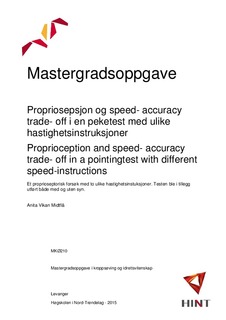| dc.description.abstract | Hensikten med denne studien var å se på om Fitt’s lov og «speed- accuracy trade- off» gjorde seg gjeldende i en proprioseptorisk test utviklet av Clas von Hofsten. 7 personer deltok i studien (1 jente og 6 gutter). Testen er en peketest og gikk ut på å matche pekefinger dominant hånd med pekefinger non-dominant hånd på henholdsvis undersiden og oversiden av en horisontal plate. Deltakerne fikk fire ulike betingelser; 1. Gjør det normalt og nøyaktig, 2. Gjør det hurtig og nøyaktig, 3. Gjør det normalt og nøyaktig uten syn og 4. Gjør det hurtig og nøyaktig uten syn. Hver deltaker gjennomførte 8 stikk per betingelse.
Dette forsøket bekrefter at testen med og uten syn gjør en vesentlig og signifikant forskjell i nøyaktigheten og bekrefter slike målinger gjort i tidligere studier. Hovedfunnet i denne studien viser at nøyaktigheten går opp når den maksimale hastigheten i stikket øker. Det betyr at speed- accuracy trade- off ikke opptrer slik det blir beskrevet i Fitts’ lov, men ser ut til best å følge en powerfunksjon i forholdet mellom hastighet og nøyaktighet. Altså kan det se ut til at det er grunnlag for å revidere Fitts’ lov for denne type ballistiske bevegelser med liten belastning.
The purpose of this study was to see if Fitts' law and speed accuracy trade of occurs in a pointingtest by using proprioception developed by Clas von Hofsten. Seven participants, six men and one woman, attended. The test is a pointingtest, and the participants had to match their index finger on dominant hand with the index finger on non-dominant hand, on the underside and the upper side of a horizontal plate. Participants were given four different conditions; 1. Make it normally and accurately 2. Do it quickly and accurately, 3. Do it normally and accurately without sight and 4. Do it quickly and accurately without sight. Each participant completed 8 hitch for each condition.
This experiment confirms that the test with and without vision makes a substantial and significant difference in accuracy and confirms such measurements made in previous studies. The main finding in this study show that the accuracy goes up when the maximum speed in the hitch increases. That means that speed- accuracy trade-off is not acting as described in Fitts' law , but seems best to follow a power function of the relationship between speed and accuracy. So it may appear that there are reasons for revising Fitts ' law for this type of ballistic movements with small resistance. | nb_NO |
